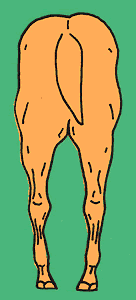Ashley Griffin, University of Kentucky
Ideally, when viewing the horse from the rear for structural correctness, an imaginary line from the point of the buttock through the gaskin, hock, and hoof should equally bisect the leg.
This straight column of bone will allow equal distribution of weight and concussion on bones, tendons, and ligaments as the hoof makes contact with the ground. In most cases, horses will naturally stand with their cannon bones parallel and their toes pointed slightly out.
This is perfectly acceptable because it allows the stifle to clear the rib cage when in flight, resulting in a longer-strided, freer-moving horse.
Cow-hocked horses are bowed in at the hocks and cannon bones instead of parallel. Typically, their hocks are set too close together, pointing inward with the feet widely separated. Cow-hocked horses tend to be weak in major movements that require work off the hindquarters, such as stopping, turning, and sliding.
Out at the hocks refers to horses that are bow-legged in the rear legs due to hocks that are too far apart. They are generally base-narrow and stand toed-in. This condition adds increased strain on the bones, ligaments, and joints and interfere with movement. These horses are generally very poor athletes and should be severely faulted.





